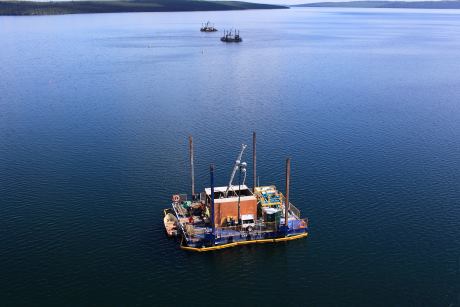The Triple R uranium deposit at Patterson Lake South in Canada could produce an estimated 100.8 million pounds U3O8 (38,770 tU) over a 14-year mine life, according to the summary results of a preliminary economic assessment (PEA) released by Fission Uranium.
 |
| Summer 2014 drilling at Patterson Lake South (Image: Fission Uranium) |
According to the PEA, the envisaged hybrid open-pit and underground operation would produce an average 7.2 million pounds U3O8 (2770 tU) per year over the 14-year life of the mine, with 77.5 million pounds U3O8 (29,810 tU) recovered in the first six years of operation. Average operating costs are estimated at $14.02 per pound U3O8 over the life of mine.
The NI43-101 compliant PEA study considers the Patterson Lake South project as a stand-alone mine and mill operation, extracting and developing the R00E and R780E zones of the Triple R deposit. The company notes that the PEA includes inferred mineral resources that are currently considered too speculative, geologically, to be categorized as reserves. However, the study's findings could potentially be enhanced by the inclusion of the R600W zone of high mineralization, which was discovered earlier this year and is still being defined.
The hybrid mining operation would see high-grade mineralization - above 4% U3O8 - captured within the open pit, eliminating the need for expensive, specialized underground mining methods. The resulting US$14.02 per pound U3O8 operating cost would make Triple R potentially one of the lowest cost uranium producers in the world, the company says.
Fission Uranium president, COO, and chief geologist Ross McElroy said that the PEA demonstrated the viability of development and profitability of the Triple R uranium deposit and confirmed it as a "robust" project with strong economics. "Additionally, a mill at PLS [Patterson Lake South] has the potential to become a key centrepiece for the Western Athabasca Basin - with the potential to process ore from other high-grade projects in the region as they are taken into production," he added.
Triple R was discovered in 2012, and it is now known to be a large, shallow and high-grade uranium deposit with 30,600 tU of indicated resources at 1.58%, including a high-grade zone with 17,000 tU at 15.4%, and 10,000 tU inferred resources at 1.3% (NI 43-101 compliant) announced earlier this year. Patterson Lake South is 100%-owned by Fission Uranium. It is currently in the process of merging with Denison Mines in a move that will consolidate the two companies' strategic Athabasca Basin uranium assets including Patterson Lake South and Denison's interests in Wheeler River and the McClean Lake uranium mill. The merger is expected to be completed in October.
Researched and written
by World Nuclear News




_30199.jpg)
_72306.jpg)

_49562.jpg)





